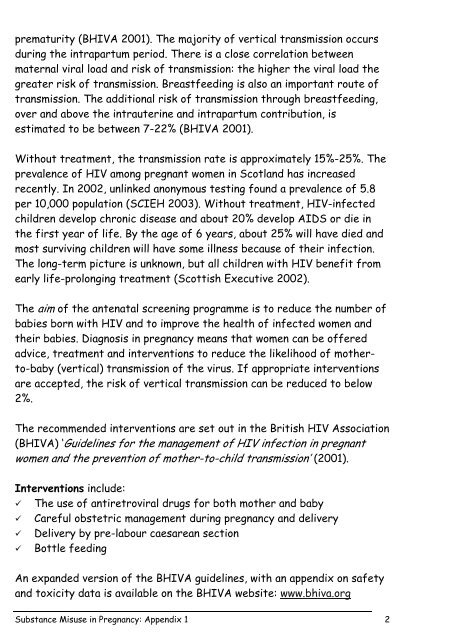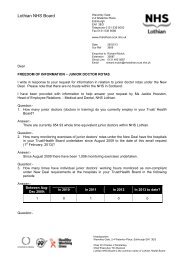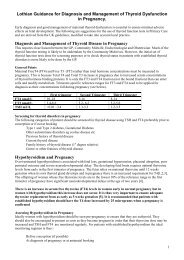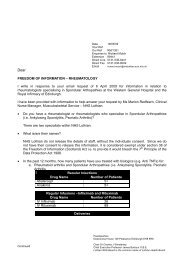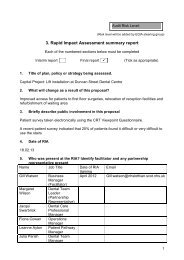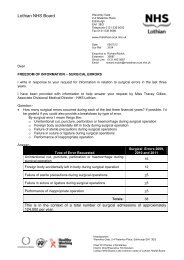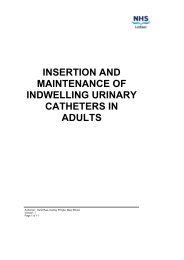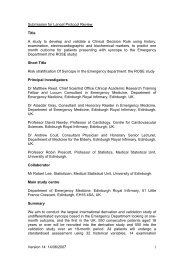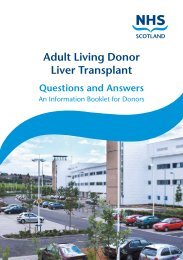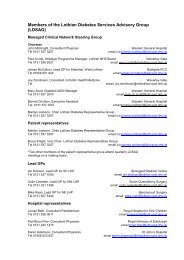Substance Misuse in Pregnancy - NHS Lothian
Substance Misuse in Pregnancy - NHS Lothian
Substance Misuse in Pregnancy - NHS Lothian
Create successful ePaper yourself
Turn your PDF publications into a flip-book with our unique Google optimized e-Paper software.
prematurity (BHIVA 2001). The majority of vertical transmission occurs<br />
dur<strong>in</strong>g the <strong>in</strong>trapartum period. There is a close correlation between<br />
maternal viral load and risk of transmission: the higher the viral load the<br />
greater risk of transmission. Breastfeed<strong>in</strong>g is also an important route of<br />
transmission. The additional risk of transmission through breastfeed<strong>in</strong>g,<br />
over and above the <strong>in</strong>trauter<strong>in</strong>e and <strong>in</strong>trapartum contribution, is<br />
estimated to be between 7-22% (BHIVA 2001).<br />
Without treatment, the transmission rate is approximately 15%-25%. The<br />
prevalence of HIV among pregnant women <strong>in</strong> Scotland has <strong>in</strong>creased<br />
recently. In 2002, unl<strong>in</strong>ked anonymous test<strong>in</strong>g found a prevalence of 5.8<br />
per 10,000 population (SCIEH 2003). Without treatment, HIV-<strong>in</strong>fected<br />
children develop chronic disease and about 20% develop AIDS or die <strong>in</strong><br />
the first year of life. By the age of 6 years, about 25% will have died and<br />
most surviv<strong>in</strong>g children will have some illness because of their <strong>in</strong>fection.<br />
The long-term picture is unknown, but all children with HIV benefit from<br />
early life-prolong<strong>in</strong>g treatment (Scottish Executive 2002).<br />
The aim of the antenatal screen<strong>in</strong>g programme is to reduce the number of<br />
babies born with HIV and to improve the health of <strong>in</strong>fected women and<br />
their babies. Diagnosis <strong>in</strong> pregnancy means that women can be offered<br />
advice, treatment and <strong>in</strong>terventions to reduce the likelihood of motherto-baby<br />
(vertical) transmission of the virus. If appropriate <strong>in</strong>terventions<br />
are accepted, the risk of vertical transmission can be reduced to below<br />
2%.<br />
The recommended <strong>in</strong>terventions are set out <strong>in</strong> the British HIV Association<br />
(BHIVA) ‘Guidel<strong>in</strong>es for the management of HIV <strong>in</strong>fection <strong>in</strong> pregnant<br />
women and the prevention of mother-to-child transmission’ (2001).<br />
Interventions <strong>in</strong>clude:<br />
� The use of antiretroviral drugs for both mother and baby<br />
� Careful obstetric management dur<strong>in</strong>g pregnancy and delivery<br />
� Delivery by pre-labour caesarean section<br />
� Bottle feed<strong>in</strong>g<br />
An expanded version of the BHIVA guidel<strong>in</strong>es, with an appendix on safety<br />
and toxicity data is available on the BHIVA website: www.bhiva.org<br />
<strong>Substance</strong> <strong>Misuse</strong> <strong>in</strong> <strong>Pregnancy</strong>: Appendix 1 2


